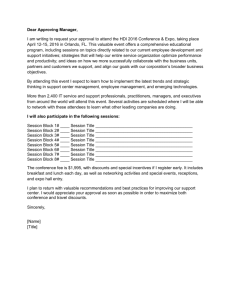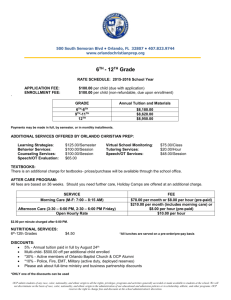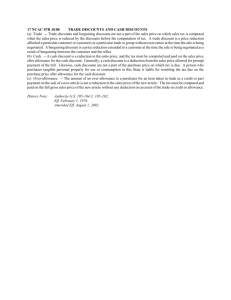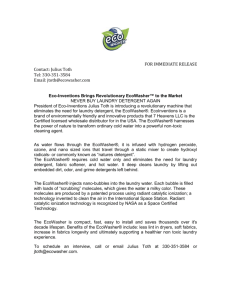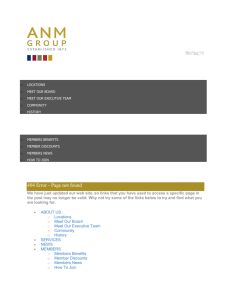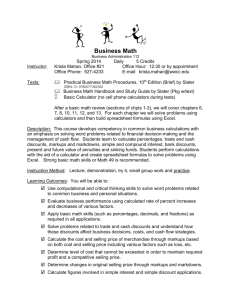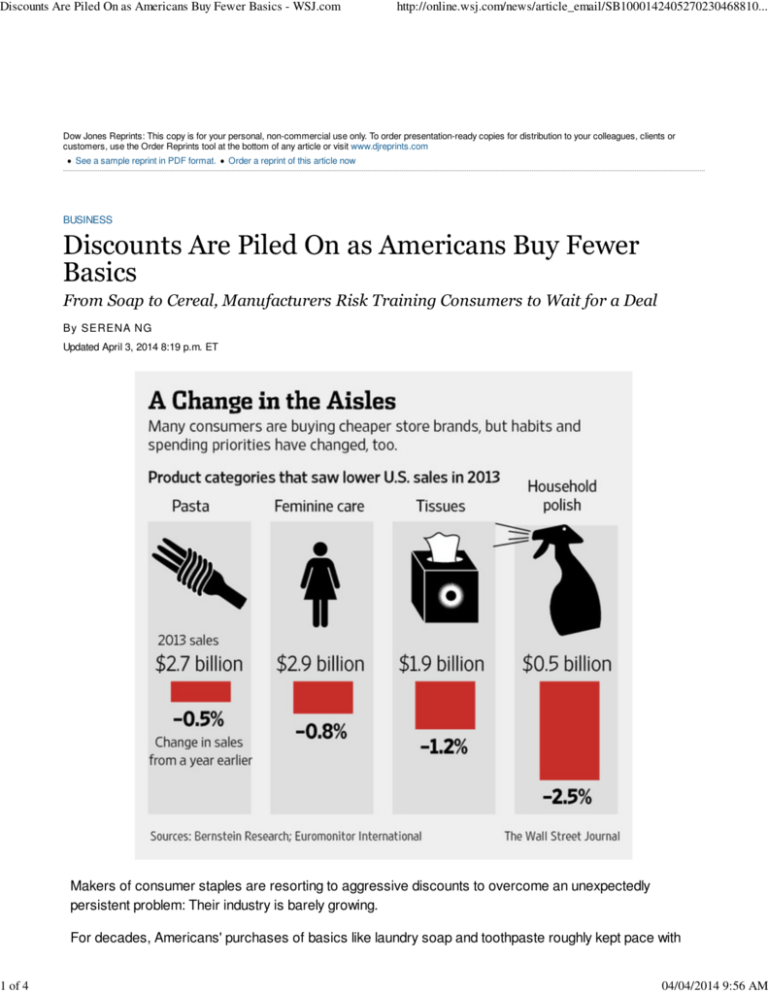
Discounts Are Piled On as Americans Buy Fewer Basics - WSJ.com
1 of 4
http://online.wsj.com/news/article_email/SB1000142405270230468810...
Dow Jones Reprints: This copy is for your personal, non-commercial use only. To order presentation-ready copies for distribution to your colleagues, clients or
customers, use the Order Reprints tool at the bottom of any article or visit www.djreprints.com
See a sample reprint in PDF format.
Order a reprint of this article now
BUSINESS
Discounts Are Piled On as Americans Buy Fewer
Basics
From Soap to Cereal, Manufacturers Risk Training Consumers to Wait for a Deal
By SERENA NG
Updated April 3, 2014 8:19 p.m. ET
Makers of consumer staples are resorting to aggressive discounts to overcome an unexpectedly
persistent problem: Their industry is barely growing.
For decades, Americans' purchases of basics like laundry soap and toothpaste roughly kept pace with
04/04/2014 9:56 AM
Discounts Are Piled On as Americans Buy Fewer Basics - WSJ.com
2 of 4
http://online.wsj.com/news/article_email/SB1000142405270230468810...
the rate of growth in the overall economy. But that rule of thumb no longer applies, which is bad news for
billion-dollar brands like Tide and Colgate.
For the past three years running, unit sales of consumer products have been largely flat, according to
market research firm Nielsen.
Many segments are affected by changing preferences, habits and spending priorities. People are eating
less cereal and drinking less soda. Razorblade sales are down as many men shave less or grow beards.
Pre-measured laundry soap capsules and higher-efficiency machines require less detergent. And more
people are choosing freshly prepared food over packaged fare.
Procter & Gamble's Downy softener and Tide laundry detergent on display at a store in Pasadena,
Calif., earlier this year. Reuters
Procter & Gamble Co. , Georgia Pacific Corp., Henkel AG and other companies have responded with a
blitz of deals and coupons in conjunction with retailers. Indeed, over a third of packaged food and
household products are now sold with discounts, as retailers and manufacturers struggle to get people to
open their wallets. In some categories, such as soda, toilet paper and potato chips, more than 50% of
consumers' purchases include discounts, said Gary Stibel, chief executive of the New England
Consulting Group, a marketing consulting firm.
"When we see some of the promotional pricing out there, it's pretty clear someone has lost their mind,"
said Bill Schmitz, a Deutsche Bank analyst who follows companies that sell beverages, household and
beauty products.
At Target Corp. stores, shoppers recently could get a $5 gift card for purchases of five Febreze
air-freshener products, a discount of more than 30% for a $15 purchase of the P&G brand. This week,
the chain is giving a $10 gift card to customers who spend $30 on Angel Soft or Quilted Northern toilet
paper, made by Georgia Pacific.
Drugstore chains CVS and Rite Aid last month touted a buy-one, get-two offer for Purex laundry
detergent. Henkel, which makes Purex, also distributed coupons for $1.50 off purchases of two bottles.
04/04/2014 9:56 AM
Discounts Are Piled On as Americans Buy Fewer Basics - WSJ.com
3 of 4
http://online.wsj.com/news/article_email/SB1000142405270230468810...
By combining both offers, shoppers could pay a little more than $8 for six jugs of detergent, or $1.35 per
50 oz. bottle, according to Christie Hardcastle, who runs a website that tracks consumer deals.
At Walgreens, Colgate Optic White toothpaste was on sale for $3
last month, and shoppers could apply a $1.50 coupon to get it at
half that price, and also receive a $2 store coupon for their next
purchase.
Some manufacturers, like Church & Dwight Co. , bemoan the
trend, and worry that the discounts will train consumers to wait for
the sale price.
"Price wars don't help growth and are not good for the industry,"
said Jim Craigie, chief executive of Church & Dwight, which owns
the Arm & Hammer brands and produces other household
products. "They are the easiest things to start, and the hardest to
finish."
P&G and Henkel declined to comment, and Georgia Pacific had
no immediate comment. Colgate-Palmolive Co. didn't respond to
requests for comment.
Sales of many essentials have suffered in the wake of the
financial crisis. Consumers cut spending and shifted to cheaper
store brands. The average American spent $2,515 on packaged consumer goods last year, up just 0.6%
from 2012, according to Nielsen. The previous year, the increase was 2%, due largely to inflation.
More
Consumer Sluggishness Seems to Be
Growth Drag, for Now
Consumer Shift Seen Favoring Midprice
Watches
Americans now devote about 10.8% of their personal
expenditures to packaged consumer goods, down from
11.2% in 2000 and 13.7% in 1990, according to Ali Dibadj
of Bernstein Research who examined data from the U.S.
Bureau of Economic Analysis.
"It's still a tough time for the average American," said Church & Dwight's Mr. Craigie. "There's nothing
wrong with the industry. You just have an economy that's stagnant and people are having to trade down."
To be sure, not all categories in the roughly $770 billion-a-year industry are stagnant or shrinking. Sales
of things like pet food, energy drinks, and Greek yogurt are seeing growth.
Related
At the ECO:comics conference in Santa Barbara,
Calif. Walmart Chairman and Former CEO Michael T.
Discounts are in the standard tool kit for consumerproducts makers. Still, the current level of activity is
particularly high. All told, some 33.7% of consumer
packaged goods—from soda and razors to shampoo,
shaving cream and paper towels—were sold on promotion
in the 12 months through February 2014, according to data
from Nielsen. That's the highest level since the U.S.
recession ended in mid-2009. The numbers exclude
alcohol, tobacco, fruits and vegetables.
The problem for makers of household basics is that
04/04/2014 9:56 AM
Discounts Are Piled On as Americans Buy Fewer Basics - WSJ.com
4 of 4
Duke says customers should not have to choose
between products that are more cheaper and those
that are more sustainable.
http://online.wsj.com/news/article_email/SB1000142405270230468810...
consumers are devoting a shrinking share of their wallets
to packaged goods as other costs of living rise more
sharply, such as health care and education.
Prices of consumer goods last year rose by 1.1% on average, in part because retailers—wary of
moderating commodity prices—were reluctant to let manufacturers raise prices as much as in previous
years.
Shoppers are visiting stores less often, partly because of the Internet. Unemployment remains high,
meaning pennies are pinched. The U.S. population is aging, and research shows older people tend to
consume and spend less. Americans, meanwhile, have been feeling more strains on their wallet from last
year's expiration of the payroll tax break. And even some cash-strapped consumers would rather spend
money on their cellphone bills than shell out more money for everyday items.
Stacia Braun, a fourth-grade teacher from Shumway, Ill., recently forked out $30 for toothpaste, makeup,
candy and dozens of other everyday items that would have added up to $200 without various discounts
and coupons.
"I never pay full price for a lot of things," said the 39-year-old mother of three, who said she often finds
generous deals at a Walgreens store 13 miles from her home.
The discounts may give some brands a temporary boost, but they aren't reversing the industry's malaise
and they erode the value of sales that do happen. Sales of household products grew just 0.6% in 2013 in
dollar terms, below the 1.9% growth in U.S. GDP and well below last year's 4.2% growth in retail sales.
Dollar sales of laundry detergent and razors actually fell, according to Nielsen's data.
Packaged-goods makers typically try to raise prices by 2% to 3% each year, and more if raw-materials
costs have risen, said Krishnakumar Davey, a managing director at market research firm IRI.
Last year, however, 98 product categories out of 309 tracked by IRI recorded price decreases, up from
57 in 2012. Shoppers on average paid less for shaving lotions, fragrances, peanut butter, laundry
detergent, pasta and mayonnaise.
Price cuts and discounts can be used effectively to encourage consumers to try a new product, or buy
something on impulse, said Doug Bennett, who analyzes companies' promotional strategies at Nielsen.
Now, however, they may just be training shoppers to hold out for deals.
Write to Serena Ng at serena.ng@wsj.com
Copyright 2013 Dow Jones & Company, Inc. All Rights Reserved
This copy is for your personal, non-commercial use only. Distribution and use of this material are governed by our Subscriber Agreement and by copyright law. For
non-personal use or to order multiple copies, please contact Dow Jones Reprints at 1-800-843-0008 or visit
www.djreprints.com
04/04/2014 9:56 AM

